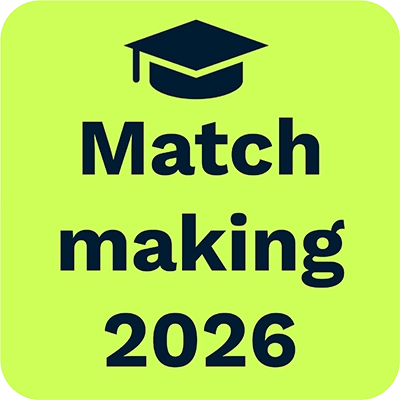Research Group Matthias Schubert
Matthias Schubert
is Professor at the Database Systems and Data Mining AI Lab and head of ‘AI-beyond: Research Group for Spatial AI’ at LMU Munich.
Reinforcement learning can learn powerful policies which enable autonomous systems to dynamically adapt to unknown situations and still perform well in maximizing expected rewards. His group develops novel solutions for spatial mobility tasks such as resource collection and allocation in highly dynamic environments. They aim to make their agents as versatile to adapt to changed conditions and variations of the environment. They further investigate risk and constraints to enforce stable outcomes in financial settings such as portfolio allocation.
Team members @MCML
PostDocs
PhD Students
Recent News @MCML
Publications @MCML
2025
[58]
J. Blake • M. Schubert
Aerial Coverage Path Planning in Nuclear Emergencies A Training and Evaluation Environment.
Demonstration Track @IJCAI 2025 - Demonstration Track at the 34th International Joint Conference on Artificial Intelligence. Montreal, Canada, Aug 16-22, 2025. DOI
Aerial Coverage Path Planning in Nuclear Emergencies A Training and Evaluation Environment.
Demonstration Track @IJCAI 2025 - Demonstration Track at the 34th International Joint Conference on Artificial Intelligence. Montreal, Canada, Aug 16-22, 2025. DOI
[57]
Z. Li • X. Han • Y. Li • N. Strauß • M. Schubert
DAWM: Diffusion Action World Models for Offline Reinforcement Learning via Action-Inferred Transitions.
WM @ICML 2025 - Workshop on Building Physically Plausible World Models at the 42nd International Conference on Machine Learning. Vancouver, Canada, Jul 13-19, 2025. arXiv
DAWM: Diffusion Action World Models for Offline Reinforcement Learning via Action-Inferred Transitions.
WM @ICML 2025 - Workshop on Building Physically Plausible World Models at the 42nd International Conference on Machine Learning. Vancouver, Canada, Jul 13-19, 2025. arXiv
[56]
L. Rottkamp
Obtaining, improving and evaluating spatio-temporal information for efficient solutions of mobility problems.
Dissertation LMU München. Jul. 2025. DOI
Obtaining, improving and evaluating spatio-temporal information for efficient solutions of mobility problems.
Dissertation LMU München. Jul. 2025. DOI
[55]
Z. Li • S. Yan • Y. Ma • Y. Li • X. Lyu • M. Schubert
Beyond Single-Step: Multi-Frame Action-Conditiones Video Generation for Reinforcement Learning Environments.
World Models @ICLR 2025 - Workshop on World Models: Understanding, Modelling and Scaling at the 13th International Conference on Learning Representations. Singapore, Apr 24-28, 2025. URL
Beyond Single-Step: Multi-Frame Action-Conditiones Video Generation for Reinforcement Learning Environments.
World Models @ICLR 2025 - Workshop on World Models: Understanding, Modelling and Scaling at the 13th International Conference on Learning Representations. Singapore, Apr 24-28, 2025. URL
2024
[54]
N. Strauß
Artificial intelligence for resource allocation tasks.
Dissertation LMU München. Dec. 2024. DOI
Artificial intelligence for resource allocation tasks.
Dissertation LMU München. Dec. 2024. DOI
[53]

D. Winkel • N. Strauß • M. Bernhard • Z. Li • T. Seidl • M. Schubert
Autoregressive Policy Optimization for Constrained Allocation Tasks.
NeurIPS 2024 - 38th Conference on Neural Information Processing Systems. Vancouver, Canada, Dec 10-15, 2024. URL GitHub
Autoregressive Policy Optimization for Constrained Allocation Tasks.
NeurIPS 2024 - 38th Conference on Neural Information Processing Systems. Vancouver, Canada, Dec 10-15, 2024. URL GitHub
[52]
C. Leiber • N. Strauß • M. Schubert • T. Seidl
Dying Clusters Is All You Need -- Deep Clustering With an Unknown Number of Clusters.
DLC 2024 @ICDM 2024 - 6th Workshop on Deep Learning and Clustering at the 24th IEEE International Conference on Data Mining. Abu Dhabi, United Arab Emirates, Dec 09-12, 2024. DOI GitHub
Dying Clusters Is All You Need -- Deep Clustering With an Unknown Number of Clusters.
DLC 2024 @ICDM 2024 - 6th Workshop on Deep Learning and Clustering at the 24th IEEE International Conference on Data Mining. Abu Dhabi, United Arab Emirates, Dec 09-12, 2024. DOI GitHub
[51]
M. Bernhard
Deep learning methods for image recognition in remote sensing.
Dissertation LMU München. Dec. 2024. DOI
Deep learning methods for image recognition in remote sensing.
Dissertation LMU München. Dec. 2024. DOI
[50]
T. Hannan • R. Koner • M. Bernhard • S. Shit • B. Menze • V. Tresp • M. Schubert • T. Seidl
GRAtt-VIS: Gated Residual Attention for Video Instance Segmentation.
ICPR 2020 - 27th International Conference on Pattern Recognition. Kolkata, India, Dec 01-05, 2024. DOI GitHub
GRAtt-VIS: Gated Residual Attention for Video Instance Segmentation.
ICPR 2020 - 27th International Conference on Pattern Recognition. Kolkata, India, Dec 01-05, 2024. DOI GitHub
[49]

M. Bernhard • T. Hannan • N. Strauß • M. Schubert
Context Matters: Leveraging Spatiotemporal Metadata for Semi-Supervised Learning on Remote Sensing Images.
ECAI 2024 - 27th European Conference on Artificial Intelligence. Santiago de Compostela, Spain, Oct 19-24, 2024. DOI GitHub
Context Matters: Leveraging Spatiotemporal Metadata for Semi-Supervised Learning on Remote Sensing Images.
ECAI 2024 - 27th European Conference on Artificial Intelligence. Santiago de Compostela, Spain, Oct 19-24, 2024. DOI GitHub
[48]

N. Strauß • M. Schubert
Spatial-Aware Deep Reinforcement Learning for the Traveling Officer Problem.
SDM 2024 - SIAM International Conference on Data Mining. Houston, TX, USA, Apr 18-20, 2024. DOI
Spatial-Aware Deep Reinforcement Learning for the Traveling Officer Problem.
SDM 2024 - SIAM International Conference on Data Mining. Houston, TX, USA, Apr 18-20, 2024. DOI
[47]
L. Rottkamp • M. Schubert
A Time-Inhomogeneous Markov Model for Resource Availability under Sparse Observations.
Preprint (Apr. 2024). arXiv
A Time-Inhomogeneous Markov Model for Resource Availability under Sparse Observations.
Preprint (Apr. 2024). arXiv
[46]

M. Bernhard • R. Amoroso • Y. Kindermann • M. Schubert • L. Baraldi • R. Cucchiara • V. Tresp
What's Outside the Intersection? Fine-grained Error Analysis for Semantic Segmentation Beyond IoU.
WACV 2024 - IEEE/CVF Winter Conference on Applications of Computer Vision. Waikoloa, Hawaii, Jan 04-08, 2024. DOI GitHub
What's Outside the Intersection? Fine-grained Error Analysis for Semantic Segmentation Beyond IoU.
WACV 2024 - IEEE/CVF Winter Conference on Applications of Computer Vision. Waikoloa, Hawaii, Jan 04-08, 2024. DOI GitHub
2023
[45]

Z. Ding • Z. Li • R. Qi • J. Wu • B. He • Y. Ma • Z. Meng • S. Chen • R. Liao • Z. Han • V. Tresp
FORECASTTKGQUESTIONS: A Benchmark for Temporal Question Answering and Forecasting over Temporal Knowledge Graphs.
ISWC 2023 - 22nd International Semantic Web Conference. Athens, Greeke, Nov 06-11, 2023. DOI
FORECASTTKGQUESTIONS: A Benchmark for Temporal Question Answering and Forecasting over Temporal Knowledge Graphs.
ISWC 2023 - 22nd International Semantic Web Conference. Athens, Greeke, Nov 06-11, 2023. DOI
[44]

M. Bernhard • N. Strauß • M. Schubert
MapFormer: Boosting Change Detection by Using Pre-change Information.
ICCV 2023 - IEEE/CVF International Conference on Computer Vision. Paris, France, Oct 02-06, 2023. DOI GitHub
MapFormer: Boosting Change Detection by Using Pre-change Information.
ICCV 2023 - IEEE/CVF International Conference on Computer Vision. Paris, France, Oct 02-06, 2023. DOI GitHub
[43]

D. Winkel • N. Strauß • M. Schubert • T. Seidl
Simplex Decomposition for Portfolio Allocation Constraints in Reinforcement Learning.
ECAI 2023 - 26th European Conference on Artificial Intelligence. Kraków, Poland, Sep 30-Oct 04, 2023. DOI
Simplex Decomposition for Portfolio Allocation Constraints in Reinforcement Learning.
ECAI 2023 - 26th European Conference on Artificial Intelligence. Kraków, Poland, Sep 30-Oct 04, 2023. DOI
[42]

Z. Ding • J. Wu • Z. Li • Y. Ma • V. Tresp
Improving Few-Shot Inductive Learning on Temporal Knowledge Graphs Using Confidence-Augmented Reinforcement Learning.
ECML-PKDD 2023 - European Conference on Machine Learning and Principles and Practice of Knowledge Discovery in Databases. Turin, Italy, Sep 18-22, 2023. DOI GitHub
Improving Few-Shot Inductive Learning on Temporal Knowledge Graphs Using Confidence-Augmented Reinforcement Learning.
ECML-PKDD 2023 - European Conference on Machine Learning and Principles and Practice of Knowledge Discovery in Databases. Turin, Italy, Sep 18-22, 2023. DOI GitHub
[41]
L. Rottkamp • N. Strauß • M. Schubert
DEAR: Dynamic Electric Ambulance Redeployment.
SSTD 2023 - 18th International Symposium on Spatial and Temporal Databases. Calgary, Canada, Aug 23-25, 2023. DOI
DEAR: Dynamic Electric Ambulance Redeployment.
SSTD 2023 - 18th International Symposium on Spatial and Temporal Databases. Calgary, Canada, Aug 23-25, 2023. DOI
[40]

A. Giovagnoli • Y. Ma • M. Schubert • V. Tresp
QNEAT: Natural Evolution of Variational Quantum Circuit Architecture.
GECCO 2023 - Genetic and Evolutionary Computation Conference. Lisbon, Portugal, Jul 15-19, 2023. DOI
QNEAT: Natural Evolution of Variational Quantum Circuit Architecture.
GECCO 2023 - Genetic and Evolutionary Computation Conference. Lisbon, Portugal, Jul 15-19, 2023. DOI
[39]
M. Fromm • M. Berrendorf • E. Faerman • T. Seidl
Cross-Domain Argument Quality Estimation.
Findings @ACL 2023 - Findings of the 61th Annual Meeting of the Association for Computational Linguistics. Toronto, Canada, Jul 09-14, 2023. DOI
Cross-Domain Argument Quality Estimation.
Findings @ACL 2023 - Findings of the 61th Annual Meeting of the Association for Computational Linguistics. Toronto, Canada, Jul 09-14, 2023. DOI
[38]
[37]

D. Winkel • N. Strauß • M. Schubert • Y. Ma • T. Seidl
Constrained Portfolio Management using Action Space Decomposition for Reinforcement Learning.
PAKDD 2023 - 27th Pacific-Asia Conference on Knowledge Discovery and Data Mining. Osaka, Japan, May 25-28, 2023. DOI
Constrained Portfolio Management using Action Space Decomposition for Reinforcement Learning.
PAKDD 2023 - 27th Pacific-Asia Conference on Knowledge Discovery and Data Mining. Osaka, Japan, May 25-28, 2023. DOI
[36]
Z. Liu • Y. Ma • M. Schubert • Y. Ouyang • W. Rong • Z. Xiong
Multimodal Contrastive Transformer for Explainable Recommendation.
IEEE Transactions on Computational Social Systems. May. 2023. DOI
Multimodal Contrastive Transformer for Explainable Recommendation.
IEEE Transactions on Computational Social Systems. May. 2023. DOI
[35]

R. Koner • T. Hannan • S. Shit • S. Sharifzadeh • M. Schubert • T. Seidl • V. Tresp
InstanceFormer: An Online Video Instance Segmentation Framework.
AAAI 2023 - 37th Conference on Artificial Intelligence. Washington, DC, USA, Feb 07-14, 2023. DOI GitHub
InstanceFormer: An Online Video Instance Segmentation Framework.
AAAI 2023 - 37th Conference on Artificial Intelligence. Washington, DC, USA, Feb 07-14, 2023. DOI GitHub
2022
[34]
N. Strauß • M. Berrendorf • T. Haider • M. Schubert
A Comparison of Ambulance Redeployment Systems on Real-World Data.
Workshop @ICDM 2022 - Workshop at the 22nd IEEE International Conference on Data Mining. Orlando, FL, USA, Nov 30-Dec 02, 2022. DOI GitHub
A Comparison of Ambulance Redeployment Systems on Real-World Data.
Workshop @ICDM 2022 - Workshop at the 22nd IEEE International Conference on Data Mining. Orlando, FL, USA, Nov 30-Dec 02, 2022. DOI GitHub
[33]

M. Bernhard • M. Schubert
Robust Object Detection in Remote Sensing Imagery with Noisy and Sparse Geo-Annotations.
ACM SIGSPATIAL 2022 - 30th ACM SIGSPATIAL International Conference on Advances in Geographic Information Systems. Seattle, WA, USA, Nov 01-04, 2022. DOI GitHub
Robust Object Detection in Remote Sensing Imagery with Noisy and Sparse Geo-Annotations.
ACM SIGSPATIAL 2022 - 30th ACM SIGSPATIAL International Conference on Advances in Geographic Information Systems. Seattle, WA, USA, Nov 01-04, 2022. DOI GitHub
[32]

C. M. M. Frey • Y. Ma • M. Schubert
SEA: Graph Shell Attention in Graph Neural Networks.
ECML-PKDD 2022 - European Conference on Machine Learning and Principles and Practice of Knowledge Discovery in Databases. Grenoble, France, Sep 19-23, 2022. DOI
SEA: Graph Shell Attention in Graph Neural Networks.
ECML-PKDD 2022 - European Conference on Machine Learning and Principles and Practice of Knowledge Discovery in Databases. Grenoble, France, Sep 19-23, 2022. DOI
[31]

N. Strauß • D. Winkel • M. Berrendorf • M. Schubert
Reinforcement Learning for Multi-Agent Stochastic Resource Collection.
ECML-PKDD 2022 - European Conference on Machine Learning and Principles and Practice of Knowledge Discovery in Databases. Grenoble, France, Sep 19-23, 2022. DOI
Reinforcement Learning for Multi-Agent Stochastic Resource Collection.
ECML-PKDD 2022 - European Conference on Machine Learning and Principles and Practice of Knowledge Discovery in Databases. Grenoble, France, Sep 19-23, 2022. DOI
[30]

D. Winkel • N. Strauß • M. Schubert • T. Seidl
Risk-Aware Reinforcement Learning for Multi-Period Portfolio Selection.
ECML-PKDD 2022 - European Conference on Machine Learning and Principles and Practice of Knowledge Discovery in Databases. Grenoble, France, Sep 19-23, 2022. DOI
Risk-Aware Reinforcement Learning for Multi-Period Portfolio Selection.
ECML-PKDD 2022 - European Conference on Machine Learning and Principles and Practice of Knowledge Discovery in Databases. Grenoble, France, Sep 19-23, 2022. DOI
[29]
Z. Ding • Z. Li • R. Qi • J. Wu • B. He • Y. Ma • Z. Meng • S. Chen • R. Liao • Z. Han • V. Tresp
Forecasting Question Answering over Temporal Knowledge Graphs.
Preprint (Aug. 2022). arXiv
Forecasting Question Answering over Temporal Knowledge Graphs.
Preprint (Aug. 2022). arXiv
[28]
Z. Liu • Y. Ma • M. Schubert • Y. Ouyang • Z. Xiong
Multi-Modal Contrastive Pre-training for Recommendation.
ICMR 2022 - ACM International Conference on Multimedia Retrieval. Newark, NJ, USA, Jun 27-30, 2022. DOI
Multi-Modal Contrastive Pre-training for Recommendation.
ICMR 2022 - ACM International Conference on Multimedia Retrieval. Newark, NJ, USA, Jun 27-30, 2022. DOI
[27]
G. Fu • Z. Meng • Z. Han • Z. Ding • Y. Ma • M. Schubert • V. Tresp • R. Wattenhofer
TempCaps: A Capsule Network-based Embedding Model for Temporal Knowledge Graph Completion.
SPNLP @ACL 2022 - 6th ACL Workshop on Structured Prediction for NLP at the 60th Annual Meeting of the Association for Computational Linguistics. Dublin, Ireland, May 22-27, 2022. DOI
TempCaps: A Capsule Network-based Embedding Model for Temporal Knowledge Graph Completion.
SPNLP @ACL 2022 - 6th ACL Workshop on Structured Prediction for NLP at the 60th Annual Meeting of the Association for Computational Linguistics. Dublin, Ireland, May 22-27, 2022. DOI
2021
[26]

M. Bernhard • M. Schubert
Correcting Imprecise Object Locations for Training Object Detectors in Remote Sensing Applications.
Remote Sensing 13. Dec. 2021. URL
Correcting Imprecise Object Locations for Training Object Detectors in Remote Sensing Applications.
Remote Sensing 13. Dec. 2021. URL
[25]
N. Kees • M. Fromm • E. Faerman • T. Seidl
Active Learning for Argument Strength Estimation.
Insights @EMNLP 2021 - 2nd Workshop on Insights from Negative Results at the Conference on Empirical Methods in Natural Language Processing. Punta Cana, Dominican Republic, Nov 07-11, 2021. DOI
Active Learning for Argument Strength Estimation.
Insights @EMNLP 2021 - 2nd Workshop on Insights from Negative Results at the Conference on Empirical Methods in Natural Language Processing. Punta Cana, Dominican Republic, Nov 07-11, 2021. DOI
[24]
N. Strauß • L. Rottkamp • S. Schmoll • M. Schubert
Efficient Parking Search using Shared Fleet Data.
MDM 2021 - 22nd IEEE International Conference on Mobile Data Management. Virtual, Jun 15-18, 2021. DOI
Efficient Parking Search using Shared Fleet Data.
MDM 2021 - 22nd IEEE International Conference on Mobile Data Management. Virtual, Jun 15-18, 2021. DOI
[23]
[22]

M. Berrendorf • E. Faerman • V. Tresp
Active Learning for Entity Alignment.
ECIR 2021 - 43rd European Conference on Information Retrieval. Virtual, Mar 28-Apr 01, 2021. DOI GitHub
Active Learning for Entity Alignment.
ECIR 2021 - 43rd European Conference on Information Retrieval. Virtual, Mar 28-Apr 01, 2021. DOI GitHub
[21]

M. Berrendorf • L. Wacker • E. Faerman
A Critical Assessment of State-of-the-Art in Entity Alignment.
ECIR 2021 - 43rd European Conference on Information Retrieval. Virtual, Mar 28-Apr 01, 2021. DOI GitHub
A Critical Assessment of State-of-the-Art in Entity Alignment.
ECIR 2021 - 43rd European Conference on Information Retrieval. Virtual, Mar 28-Apr 01, 2021. DOI GitHub
[20]

M. Fromm • M. Berrendorf • S. Gilhuber • T. Seidl • E. Faerman
Diversity Aware Relevance Learning for Argument Search.
ECIR 2021 - 43rd European Conference on Information Retrieval. Virtual, Mar 28-Apr 01, 2021. DOI GitHub
Diversity Aware Relevance Learning for Argument Search.
ECIR 2021 - 43rd European Conference on Information Retrieval. Virtual, Mar 28-Apr 01, 2021. DOI GitHub
[19]

M. Fromm • E. Faerman • M. Berrendorf • S. Bhargava • R. Qi • Y. Zhang • L. Dennert • S. Selle • Y. Mao • T. Seidl
Argument Mining Driven Analysis of Peer-Reviews.
AAAI 2021 - 35th Conference on Artificial Intelligence. Virtual, Feb 02-09, 2021. DOI GitHub
Argument Mining Driven Analysis of Peer-Reviews.
AAAI 2021 - 35th Conference on Artificial Intelligence. Virtual, Feb 02-09, 2021. DOI GitHub
[18]

S. Schmoll • M. Schubert
Semi-Markov Reinforcement Learning for Stochastic Resource Collection.
IJCAI 2020 - 29th International Joint Conference on Artificial Intelligence. Yokohama, Japan (postponed due to the Corona pandemic), Jan 07-15, 2021. DOI
Semi-Markov Reinforcement Learning for Stochastic Resource Collection.
IJCAI 2020 - 29th International Joint Conference on Artificial Intelligence. Yokohama, Japan (postponed due to the Corona pandemic), Jan 07-15, 2021. DOI
2020
[17]
M. Berrendorf • E. Faerman • L. Vermue • V. Tresp
Interpretable and Fair Comparison of Link Prediction or Entity Alignment Methods with Adjusted Mean Rank.
WI-IAT 2020 - IEEE/WIC/ACM International Joint Conference on Web Intelligence and Intelligent Agent Technology. Virtual, Dec 14-17, 2020. DOI
Interpretable and Fair Comparison of Link Prediction or Entity Alignment Methods with Adjusted Mean Rank.
WI-IAT 2020 - IEEE/WIC/ACM International Joint Conference on Web Intelligence and Intelligent Agent Technology. Virtual, Dec 14-17, 2020. DOI
[16]
E. Faerman • F. Borutta • J. Busch • M. Schubert
Ada-LLD: Adaptive Node Similarity Using Multi-Scale Local Label Distributions.
WI-IAT 2020 - IEEE/WIC/ACM International Joint Conference on Web Intelligence and Intelligent Agent Technology. Virtual, Dec 14-17, 2020. DOI GitHub
Ada-LLD: Adaptive Node Similarity Using Multi-Scale Local Label Distributions.
WI-IAT 2020 - IEEE/WIC/ACM International Joint Conference on Web Intelligence and Intelligent Agent Technology. Virtual, Dec 14-17, 2020. DOI GitHub
[15]
J. Busch • E. Faerman • M. Schubert • T. Seidl
Learning Self-Expression Metrics for Scalable and Inductive Subspace Clustering.
SSL @NeurIPS 2020 - Workshop on Self-Supervised Learning - Theory and Practice at the 34th Conference on Neural Information Processing Systems. Virtual, Dec 06-12, 2020. arXiv GitHub
Learning Self-Expression Metrics for Scalable and Inductive Subspace Clustering.
SSL @NeurIPS 2020 - Workshop on Self-Supervised Learning - Theory and Practice at the 34th Conference on Neural Information Processing Systems. Virtual, Dec 06-12, 2020. arXiv GitHub
[14]
[13]
[12]
V. Melnychuk • E. Faerman • I. Manakov • T. Seidl
Matching the Clinical Reality: Accurate OCT-Based Diagnosis From Few Labels.
Workshop @CIKM 2020 - Workshop at the 29th ACM International Conference on Information and Knowledge Management. Galway, Ireland, Oct 19-23, 2020. PDF GitHub
Matching the Clinical Reality: Accurate OCT-Based Diagnosis From Few Labels.
Workshop @CIKM 2020 - Workshop at the 29th ACM International Conference on Information and Knowledge Management. Galway, Ireland, Oct 19-23, 2020. PDF GitHub
[11]
[10]
M. Berrendorf • E. Faerman • V. Tresp
Active Learning for Entity Alignment.
DL4G @WWW 2020 - 5th International Workshop on Deep Learning for Graphs at the International World Wide Web Conference. Taipeh, Taiwan, Apr 21, 2020. arXiv
Active Learning for Entity Alignment.
DL4G @WWW 2020 - 5th International Workshop on Deep Learning for Graphs at the International World Wide Web Conference. Taipeh, Taiwan, Apr 21, 2020. arXiv
[9]
M. Berrendorf • E. Faerman • L. Vermue • V. Tresp
Interpretable and Fair Comparison of Link Prediction or Entity Alignment Methods with Adjusted Mean Rank (Extended Abstract).
DL4G @WWW 2020 - 5th International Workshop on Deep Learning for Graphs at the International World Wide Web Conference. Taipeh, Taiwan, Apr 21, 2020. Full paper at WI-AT 2020. DOI
Interpretable and Fair Comparison of Link Prediction or Entity Alignment Methods with Adjusted Mean Rank (Extended Abstract).
DL4G @WWW 2020 - 5th International Workshop on Deep Learning for Graphs at the International World Wide Web Conference. Taipeh, Taiwan, Apr 21, 2020. Full paper at WI-AT 2020. DOI
[8]

M. Berrendorf • E. Faerman • V. Melnychuk • V. Tresp • T. Seidl
Knowledge Graph Entity Alignment with Graph Convolutional Networks: Lessons Learned.
ECIR 2020 - 42nd European Conference on Information Retrieval. Virtual, Apr 14-17, 2020. DOI GitHub
Knowledge Graph Entity Alignment with Graph Convolutional Networks: Lessons Learned.
ECIR 2020 - 42nd European Conference on Information Retrieval. Virtual, Apr 14-17, 2020. DOI GitHub
[7]
D. Davletshina • V. Melnychuk • V. Tran • H. Singla • M. Berrendorf • E. Faerman • M. Fromm • M. Schubert
Unsupervised Anomaly Detection for X-Ray Images.
Preprint (Jan. 2020). arXiv GitHub
Unsupervised Anomaly Detection for X-Ray Images.
Preprint (Jan. 2020). arXiv GitHub
2019
[6]
E. Faerman • O. Voggenreiter • F. Borutta • T. Emrich • M. Berrendorf • M. Schubert
Graph Alignment Networks with Node Matching Scores.
Graph Representation Learning @NeurIPS 2019 - Workshop on Graph Representation Learning at the 33rd Conference on Neural Information Processing Systems. Vancouver, Canada, Dec 08-14, 2019. PDF
Graph Alignment Networks with Node Matching Scores.
Graph Representation Learning @NeurIPS 2019 - Workshop on Graph Representation Learning at the 33rd Conference on Neural Information Processing Systems. Vancouver, Canada, Dec 08-14, 2019. PDF
[5]
E. Faerman • M. Rogalla • N. Strauß • A. Krüger • B. Blümel • M. Berrendorf • M. Fromm • M. Schubert
Spatial Interpolation with Message Passing Framework.
Workshop @ICDM 2019 - Workshop at the 19th IEEE International Conference on Data Mining. Beijing, China, Nov 08-11, 2019. DOI
Spatial Interpolation with Message Passing Framework.
Workshop @ICDM 2019 - Workshop at the 19th IEEE International Conference on Data Mining. Beijing, China, Nov 08-11, 2019. DOI
[4]
M. Fromm • M. Berrendorf • E. Faerman • Y. Chen • B. Schüss • M. Schubert
XD-STOD: Cross-Domain Superresolution for Tiny Object Detection.
Workshop @ICDM 2019 - Workshop at the 19th IEEE International Conference on Data Mining. Beijing, China, Nov 08-11, 2019. DOI
XD-STOD: Cross-Domain Superresolution for Tiny Object Detection.
Workshop @ICDM 2019 - Workshop at the 19th IEEE International Conference on Data Mining. Beijing, China, Nov 08-11, 2019. DOI
[3]
F. Borutta • J. Busch • E. Faerman • A. Klink • M. Schubert
Structural Graph Representations based on Multiscale Local Network Topologies.
WI 2019 - IEEE/WIC/ACM International Conference on Web Intelligence. Thessaloniki, Greece, Oct 14-17, 2019. DOI
Structural Graph Representations based on Multiscale Local Network Topologies.
WI 2019 - IEEE/WIC/ACM International Conference on Web Intelligence. Thessaloniki, Greece, Oct 14-17, 2019. DOI
[2]
M. Fromm • E. Faerman • T. Seidl
TACAM: Topic And Context Aware Argument Mining.
WI 2019 - IEEE/WIC/ACM International Conference on Web Intelligence. Thessaloniki, Greece, Oct 14-17, 2019. DOI
TACAM: Topic And Context Aware Argument Mining.
WI 2019 - IEEE/WIC/ACM International Conference on Web Intelligence. Thessaloniki, Greece, Oct 14-17, 2019. DOI
[1]
S. Schmoll • S. Friedl • M. Schubert
Scaling the Dynamic Resource Routing Problem.
SSTD 2019 - 16th International Symposium on Spatial and Temporal Databases. Vienna, Austria, Aug 19-21, 2019. DOI
Scaling the Dynamic Resource Routing Problem.
SSTD 2019 - 16th International Symposium on Spatial and Temporal Databases. Vienna, Austria, Aug 19-21, 2019. DOI
©all images: LMU | TUM






